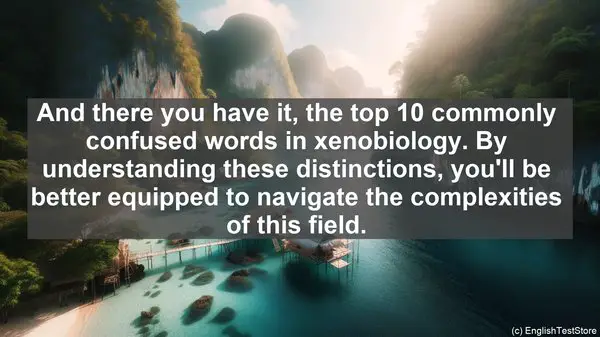Introduction
Welcome to today’s lesson on xenobiology. In this lesson, we will be discussing the top 10 commonly confused words in this fascinating field. Understanding these words correctly is crucial for your studies, so let’s dive in!
1. Extraterrestrial vs. Alien
While both terms refer to beings from outer space, ‘extraterrestrial’ is a broader term that encompasses any life form originating outside Earth, whereas ‘alien’ specifically refers to non-human entities. So, when discussing the possibility of life on other planets, we use ‘extraterrestrial,’ but when referring to non-human creatures, ‘alien’ is more appropriate.
2. Telepathy vs. Telekinesis
These two psychic abilities are often confused. ‘Telepathy’ is the ability to communicate with others using only the mind, while ‘telekinesis’ is the power to move objects with one’s thoughts. So, if you’re talking about reading someone’s mind, it’s ‘telepathy,’ but if you’re referring to moving objects without physical contact, it’s ‘telekinesis.’
3. Cloning vs. Replication
In xenobiology, ‘cloning’ involves creating an exact genetic replica of an organism, while ‘replication’ refers to the process of duplicating genetic material. So, ‘cloning’ results in a complete copy of the organism, while ‘replication’ can be a partial or complete duplication of genetic material.
4. Hybrid vs. Chimera
Both terms refer to organisms with genetic material from different species, but there’s a distinction. A ‘hybrid’ is the offspring of two different species, while a ‘chimera’ is an organism with cells from two or more genetically distinct individuals. So, a ‘hybrid’ has genetic material from two species, while a ‘chimera’ can have genetic material from multiple individuals of the same species.
5. Ecosystem vs. Biosphere
While both terms relate to the environment, they have different scopes. An ‘ecosystem’ refers to a specific community of organisms and their physical environment, whereas the ‘biosphere’ encompasses all ecosystems on Earth. So, an ‘ecosystem’ is a smaller unit within the ‘biosphere.’

6. Mutation vs. Variation
In genetics, ‘mutation’ refers to a permanent change in the DNA sequence, often resulting in a new trait. On the other hand, ‘variation’ refers to the natural differences that exist within a population. So, ‘mutation’ is a specific type of ‘variation’ that involves a genetic change.

7. Extinct vs. Endangered
These terms describe the status of a species, but at different levels of risk. ‘Extinct’ means a species no longer exists, while ‘endangered’ means a species is at risk of becoming extinct. So, ‘extinct’ is a more severe status than ‘endangered.’
8. Autotroph vs. Heterotroph
These terms describe an organism’s source of energy. An ‘autotroph’ can produce its own food using sunlight or inorganic substances, while a ‘heterotroph’ relies on consuming other organisms for energy. So, plants are ‘autotrophs,’ while animals are ‘heterotrophs.’
9. Symbiosis vs. Mutualism
Both terms describe close relationships between different species, but there’s a distinction. ‘Symbiosis’ refers to any interaction where two species live together, while ‘mutualism’ specifically describes a symbiotic relationship where both species benefit. So, ‘mutualism’ is a type of ‘symbiosis.’
10. Anatomy vs. Morphology
While both terms relate to the study of organism structure, they have different focuses. ‘Anatomy’ is concerned with the internal and external structures of an organism, while ‘morphology’ encompasses the overall form and appearance. So, ‘anatomy’ is more specific, while ‘morphology’ is broader.
